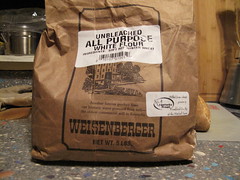Thoughts on Flour
Flours that I have used:
Hecker's Unbleached All Purpose Flour
Hecker's Whole Wheat Flour
Gold Medal Whole Wheat Flour
Arrowhead Mills Organic Unbleached All Purpose Flour
Arrowhead Mills Organic Rye Flour
Whole Foods Market 365 Unbleached All Purpose Flour
Whole Foods Market 365 Whole Wheat Flour
King Arthur Unbleached All Purpose Flour
King Arthur Unbleached Bread Flour
King Arthur Organic Unbleached Bread Flour
Bob's Red Mill Organic Unbleached Bread Flour
Bob's Red Mill Semonlina Flour
- Log in or register to post comments
- View post
- breadbakingbassplayer's Blog

